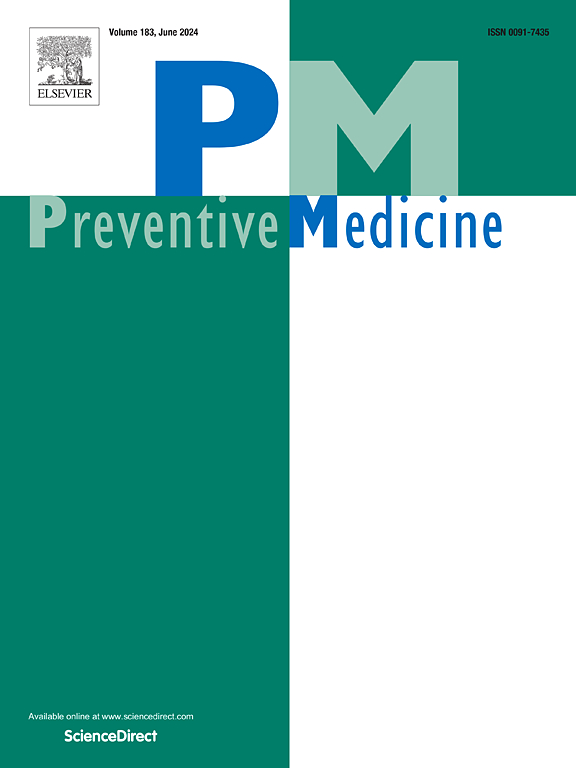E-cigarette use and respiratory illnesses among U.S. adults: An analysis of the Population Assessment of Tobacco and Health Study
IF 4.3
2区 医学
Q1 MEDICINE, GENERAL & INTERNAL
引用次数: 0
Abstract
Introduction
Electronic cigarettes (e-cigarette) entered the United States marketplace in 2007. Because of the chemical composition of e-cigarette liquid, there are concerns related to its effects on respiratory illnesses.
Methods
Using Wave 4 (2016–2018) of the adult (≥18 years of age) Population Assessment of Tobacco and Health study, logistic regression was used to quantify the association between e-cigarette use and any respiratory illness (asthma, chronic bronchitis, COPD, emphysema, or other lung or respiratory conditions). Age, gender, and the use of other tobacco products were assessed as modifiers of this relationship via interactions on the additive and multiplicative scales.
Results
After adjustment, ever e-cigarette use was associated with a 1.32 (95 % confidence intervals [CI]:1.03, 1.69) greater odds of any respiratory illness compared with never e-cigarette users among U.S. adults. When comparing ever and never e-cigarette users, older adults (Odds Ratio [OR] = 1.65, 95 %CI:1.20, 2.26), and ever users of other tobacco products (OR = 1.77, 95 %CI:1.37, 2.29) had greater odds of reporting any respiratory illness than younger adults and those who never used other tobacco products. Among never e-cigarette users, men (OR = 1.51, 95 %CI:1.12, 2.04) were less likely to report any respiratory illness than women. Only the joint effect of age and e-cigarette use on any respiratory illness was statistically significant, suggesting this effect was greater than expected on the additive and multiplicative scales.
Conclusion
These findings suggest that the relationship between e-cigarette use and any respiratory illness varies with age. Interventions and policies to reduce e-cigarette use should target high-risk groups for any respiratory illness.
美国成年人使用电子烟与呼吸道疾病:烟草与健康人口评估研究分析。
导言:电子香烟于 2007 年进入美国市场。由于电子烟液体的化学成分,人们担心其对呼吸系统疾病的影响:利用成人(≥18 岁)烟草与健康人口评估研究的第 4 波(2016-2018 年),使用逻辑回归量化电子烟使用与任何呼吸系统疾病(哮喘、慢性支气管炎、慢性阻塞性肺病、肺气肿或其他肺部或呼吸系统疾病)之间的关联。年龄、性别和使用其他烟草产品的情况通过加法和乘法量表上的交互作用被评估为这一关系的调节因素:经调整后,在美国成年人中,与从未使用过电子烟的人相比,曾经使用过电子烟的人患任何呼吸道疾病的几率比从未使用过电子烟的人高出 1.32(95 % 置信区间 [CI]:1.03, 1.69)。与曾经和从未使用过电子烟的人群相比,老年人(Odds Ratio [OR] = 1.65,95 %CI:1.20, 2.26)和曾经使用过其他烟草制品的人群(OR = 1.77,95 %CI:1.37, 2.29)报告患有任何呼吸道疾病的几率要高于年轻人和从未使用过其他烟草制品的人群。在从未使用过电子烟的人群中,男性(OR = 1.51,95 %CI:1.12, 2.04)报告任何呼吸道疾病的几率低于女性。只有年龄和使用电子烟对任何呼吸道疾病的共同影响具有统计学意义,表明这种影响大于加法和乘法量表的预期:这些研究结果表明,使用电子烟与任何呼吸道疾病之间的关系因年龄而异。减少电子烟使用的干预措施和政策应针对任何呼吸道疾病的高危人群。
本文章由计算机程序翻译,如有差异,请以英文原文为准。
求助全文
约1分钟内获得全文
求助全文
来源期刊

Preventive medicine
医学-公共卫生、环境卫生与职业卫生
CiteScore
7.70
自引率
3.90%
发文量
0
审稿时长
42 days
期刊介绍:
Founded in 1972 by Ernst Wynder, Preventive Medicine is an international scholarly journal that provides prompt publication of original articles on the science and practice of disease prevention, health promotion, and public health policymaking. Preventive Medicine aims to reward innovation. It will favor insightful observational studies, thoughtful explorations of health data, unsuspected new angles for existing hypotheses, robust randomized controlled trials, and impartial systematic reviews. Preventive Medicine''s ultimate goal is to publish research that will have an impact on the work of practitioners of disease prevention and health promotion, as well as of related disciplines.
 求助内容:
求助内容: 应助结果提醒方式:
应助结果提醒方式:


